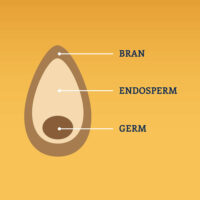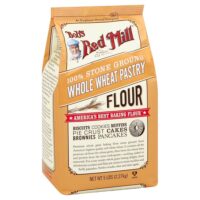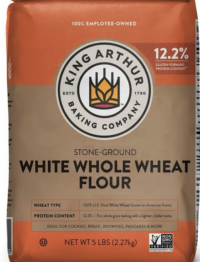White vs. Whole Wheat Flour by Avery Ashley
go.ncsu.edu/readext?878192
en Español / em Português
El inglés es el idioma de control de esta página. En la medida en que haya algún conflicto entre la traducción al inglés y la traducción, el inglés prevalece.
Al hacer clic en el enlace de traducción se activa un servicio de traducción gratuito para convertir la página al español. Al igual que con cualquier traducción por Internet, la conversión no es sensible al contexto y puede que no traduzca el texto en su significado original. NC State Extension no garantiza la exactitud del texto traducido. Por favor, tenga en cuenta que algunas aplicaciones y/o servicios pueden no funcionar como se espera cuando se traducen.
Português
Inglês é o idioma de controle desta página. Na medida que haja algum conflito entre o texto original em Inglês e a tradução, o Inglês prevalece.
Ao clicar no link de tradução, um serviço gratuito de tradução será ativado para converter a página para o Português. Como em qualquer tradução pela internet, a conversão não é sensivel ao contexto e pode não ocorrer a tradução para o significado orginal. O serviço de Extensão da Carolina do Norte (NC State Extension) não garante a exatidão do texto traduzido. Por favor, observe que algumas funções ou serviços podem não funcionar como esperado após a tradução.
English
English is the controlling language of this page. To the extent there is any conflict between the English text and the translation, English controls.
Clicking on the translation link activates a free translation service to convert the page to Spanish. As with any Internet translation, the conversion is not context-sensitive and may not translate the text to its original meaning. NC State Extension does not guarantee the accuracy of the translated text. Please note that some applications and/or services may not function as expected when translated.
Collapse ▲Most people these days know that whole wheat flour is “better for you” than refined white flour. But what exactly does that mean, and how can you use whole wheat flour in your cooking without compromising the taste and texture of your baked and fried foods? In this article we will be exploring both of those questions with the goal of demystifying the terms, and providing tips that can help you integrate more whole wheat into your diet without drastically changing the quality of your recipes
Whole Wheat Nutrition: The USDAs nutrition guidelines recommend that all Americans should be consuming at least 50% of their grains in the form of “whole grains”. But what are whole grains? The answer is fairly simple. The image below is a basic diagram of a wheat grain. Notice that the grain has three main parts, the bran, the germ, and the endosperm. Each of these three parts are made differently and serve a different purpose for the seed.
- Bran: The bran is the outer, protective layer of the wheat grain. It is rich in healthy fiber and B vitamins.
- Germ: The germ is the “baby plant” inside of the grain. If you were to plant a wheat grain, this is the part that would sprout. It is packed with E and B vitamins, as well as healthy fats, proteins, and disease fighting phytochemicals.
- Endosperm: The endosperm is essentially a form of food storage for the germ. It is mostly made of starch, with a small amount of vitamins and protein.
In the process of making refined white flour, both the bran and the germ are removed from the grain, leaving behind only the starchy endosperm. For cooks, this is a useful process because white flour made from only the endosperm has a light texture, and a delicious starchy taste. However, from a nutrition perspective, this is a downgrade because we are losing out on all of those healthy nutrients that are in the bran and germ.
How to cook with Whole Wheat Flour: If you take a recipe designed for refined white flour, and use whole wheat flour instead, you will be significantly improving the nutritional value of the food, but you may also be disappointed with its heavier taste and texture. Here are three tips that can help you use more whole wheat flour without compromising taste and texture.
- Use recipes designed for whole wheat flour: Whole wheat flour absorbs water differently than refined white flour. for this reason, using a recipe that is designed for use with whole wheat flour will often yield better results.
- Use half whole wheat and half refined white flour: Even if you only substitute half of the refined white flour in your recipe with whole wheat flour, you will still be substantially improving the nutritional quality of your food. And keeping in half of the refined white flour will yield a product that is closer to what you’re used to.
- Use “white whole wheat flour”: This is whole wheat flour that is made from a slightly different variety of wheat grain that has characteristics that make it behave more like refined white flour, without getting rid of any of the nutritional benefits of whole grains. This is my favorite option for whole wheat cooking, and I can say from experience that it works in every recipe I have tried it in, including cookie recipes! White whole wheat flour can usually be found in either the “King Arthur” brand, which is great for all purpose baking, or the “Bob’s Red Mill” pastry flour brand, which is great for more delicate baked goods.







